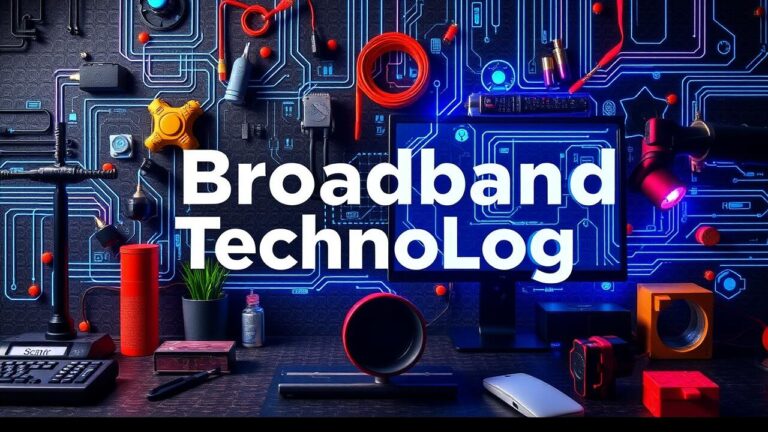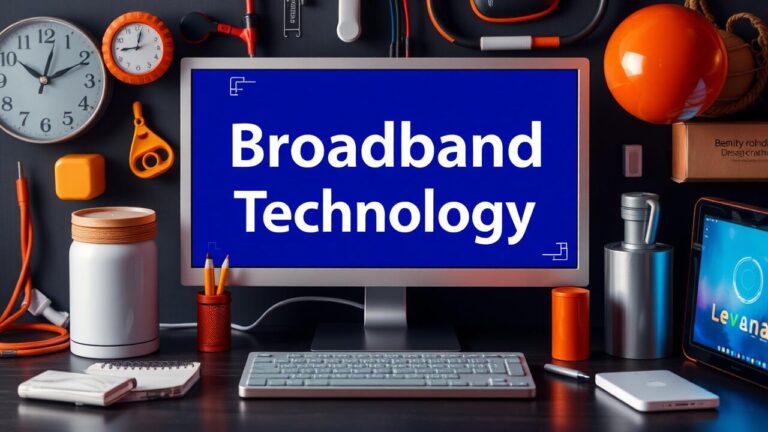Unraveling Broadband: Defining the Backbone of Modern Connectivity
In today’s hyper-connected world, broadband internet is the lifeline that keeps our personal and professional lives running smoothly. But what exactly is broadband, and why is it so crucial for modern connectivity? Let’s dive into the essentials of broadband, its importance, and how it forms the backbone of our digital age.
What is Broadband?
Broadband is a high-speed internet connection that is always on and faster than traditional dial-up access. It encompasses a wide range of high-capacity transmission technologies such as DSL (Digital Subscriber Line), cable modem, fiber-optic, wireless, satellite, and BPL (Broadband over Powerlines). These technologies offer various speeds, ranging from a few Mbps (megabits per second) to Gbps (gigabits per second), enabling a seamless online experience.
Types of Broadband Connections
Understanding the different types of broadband connections can help you choose the best option for your needs. Here’s an informative list of the main types:
- DSL (Digital Subscriber Line): Utilizes existing telephone lines to provide internet access. It’s widely available and offers speeds suitable for most household activities.
- Cable Modem: Uses the same coaxial cable network as cable television, providing higher speeds than DSL and serving as a common choice for many households.
- Fiber-Optic: Employs thin strands of glass or plastic fibers to transmit data as light signals. It offers the highest speeds and reliability but is less widely available.
- Wireless: Includes technologies like Wi-Fi and 4G/5G mobile networks, offering flexibility and mobility but with variable speeds depending on coverage and network congestion.
- Satellite: Delivers internet access through satellites orbiting the Earth, ideal for rural or remote areas where other types of broadband are unavailable.
- BPL (Broadband over Powerlines): Uses electrical power distribution networks to provide internet access. It’s a promising technology but still in the developmental stages.
Why is Broadband Essential?
Broadband is not just about fast internet speeds; it’s a critical enabler of various aspects of modern life:
- Economic Growth: High-speed internet access boosts productivity, innovation, and competitiveness, driving economic growth and job creation.
- Education: With broadband, students can access online resources, attend virtual classes, and collaborate with peers and educators globally.
- Healthcare: Telemedicine and remote patient monitoring rely on robust broadband connections to provide timely and efficient healthcare services.
- Entertainment: Streaming services, online gaming, and social media platforms depend on high-speed internet for a smooth and immersive experience.
- Communication: Broadband enables video conferencing, instant messaging, and VoIP (Voice over Internet Protocol) services, connecting people across the globe.
The Importance of Broadband in the Digital Age
When we talk about broadband internet, we’re referring to more than just a fast connection. It’s the foundation of digital communication, enabling everything from remote work to streaming your favorite shows. As our dependence on digital services grows, so does the need for reliable and high-speed broadband. Understanding the importance of broadband can help us appreciate its role in shaping our modern lives.
Broadband in Everyday Life
Think about how many devices in your home rely on a broadband connection. From smartphones and laptops to smart TVs and home automation systems, broadband is the common thread that ties them all together. Without a reliable broadband connection, many of the conveniences and efficiencies we’ve come to expect in our daily lives would be impossible.
Choosing the Right Broadband Connection
Selecting the right broadband connection depends on your specific needs and circumstances. Here’s a breakdown of factors to consider:
- Speed Requirements: Determine the speed you need based on your online activities. For instance, streaming HD videos or gaming online requires higher speeds than browsing the web or checking emails.
- Availability: Check which broadband options are available in your area. Rural areas might have limited choices compared to urban locations.
- Cost: Compare the costs of different broadband plans, considering both the monthly fees and any additional charges for equipment or installation.
- Reliability: Look for providers with a reputation for reliability and good customer service to ensure a consistent and problem-free internet experience.
The Future of Broadband
The future of broadband looks promising with advancements in technology and infrastructure. Here are a few trends to watch:
- 5G Networks: The rollout of 5G promises ultra-fast speeds and low latency, revolutionizing mobile connectivity and enabling new applications like autonomous vehicles and smart cities.
- Fiber-Optic Expansion: Continued investment in fiber-optic networks will increase availability and speeds, providing a more reliable and future-proof broadband solution.
- Satellite Internet: Innovations in satellite technology, such as low Earth orbit (LEO) satellites, will enhance coverage and performance, making high-speed internet accessible even in the most remote areas.
Conclusion
Broadband is the backbone of modern connectivity, essential for economic growth, education, healthcare, entertainment, and communication. Understanding the various types of broadband connections and their applications can help you make informed decisions and appreciate the role broadband plays in our digital world. As technology continues to evolve, broadband will only become more integral to our daily lives, driving innovation and connecting us in ways we never thought possible.
So, next time you enjoy a seamless video call with a loved one or stream your favorite movie without buffering, take a moment to appreciate the broadband connection making it all possible. It’s more than just an internet service; it’s the key to unlocking the full potential of our connected world.







